Abstract
We give fourth-order accurate implicit methods for the computation of the first-order spatial derivatives and second-order mixed derivatives involving the time derivative of the solution of first type boundary value problem of two dimensional heat equation. The methods are constructed based on two stages: At the first stage of the methods, the solution and its derivative with respect to time variable are approximated by using the implicit scheme in Buranay and Arshad in 2020. Therefore, of convergence on constructed hexagonal grids is obtained that the step sizes in the space variables , and in time variable are indicated by h, and , respectively. Special difference boundary value problems on hexagonal grids are constructed at the second stages to approximate the first order spatial derivatives and the second order mixed derivatives of the solution. Further, order of uniform convergence of these schemes are shown for . Additionally, the methods are applied on two sample problems.
Keywords:
implicit schemes; hexagonal grid; incomplete block matrix factorization; heat equation; computation of derivatives MSC:
65M06; 65M12; 65M22
1. Introduction
The modeling of numerous phenomena in diverse scientific fields leads us to consider conventional or fractional boundary value problems of time dependent differential equations on a modeling domain such as the first and second type boundary value problems to heat equation or diffusion equation. For example, the Brownian motion problem in statistics is modeled by heat equation via the Fokker–Planck equation (Adriaan Fokker [] and Max Planck []). It is also named as the Kolmogorov forward equation, who discovered the concept in 1931, see in [] independently. The stock market fluctuations represent one of the several important real-world applications of the mathematical model of Brownian motion. It was first given in the PhD thesis titled as “The theory of speculation”, by Louis Bachelier (see Mandelbrot and Hudson []) in 1900.
Another representative sample of problems that mathematical modeling brings about the heat equation is the image processing problems appearing through many applied sciences from archaeology to zoology. Examples of archaeological investigations include a camcorder for 3D underwater reconstruction of archeological objects in the study of Meline et al. []. Furthermore, a recent investigation by Woźniak and Polap [] gave soft trees with neural components as image processing technique for archeological excavations. In zoology, a study of image reconstruction problem by the application of magnetic resonance imaging was given by Ziegler et al. [] and in medical sciences as medical image reconstruction was studied in Zeng []. Furthermore, tomography, and medical and industrial applications are archetypal examples where substantial mathematical manipulation is required. In some cases, the aim is humble denoising or de-blurring. Witkin [] and Koenderink [] gave the modeling of blurring of an image by the heat equation. Later, a problem of solving the reverse heat equation known as de-blurring is studied in Rudin et al. [] and Guichard and Morel [].
Additionally, in mathematical biology, Wolpert [,] gave a phenomenological concept of pattern formation and differentiation known as positional information. The pre-programming of the cells for reacting to a chemical concentration and differentiate accordingly, into different kinds of cells such as cartilage cells was proposed. Afterwards, the animal coat patterns, pattern formation on growing domains as alligators, snakes and bacterial patterns were modeled by reaction diffusion equations in Murray []. Furthermore, therein, gliomas or glioblastomas, which are highly diffusive brain tumors, are analyzed and a mathematical model for the spatiotemporal dynamics of tumor growth was developed. Therefore, the basic model in dimensional form was given by the diffusion equation
where is the number of cells at a position and time represents the net rate of growth of cells including proliferation and death (or loss), and diffusional flux of cells taken , where (distance/time) is the diffusion coefficient of cells in brain tissue and is the gradient operator.
In general, finding analytical solutions of these modeled problems is a difficult task or even not possible. Approximations are needed when a mathematical model is switched to a numerical model. Finite difference methods (FDM) are a class of numerical techniques for solving differential equations that each derivative appearing in the partial differential equation has to be replaced by a suitable divided difference of function values at the chosen grid points, see Grossman et al. []. In the last decade, the use of advanced computers has led to the widespread use of FDM in modern numerical analysis. For example, recently, a study on fractional diffusion equation-based image denoising model using Crank–Nicholson and Grünwald Letnikov difference schemes (CN–GL) have been given in Abirami et al. []. Another example is the most recent investigation by Buranay and Nouman [] in which computation of the solution to heat equation
on special polygons, where and f is the heat source by using implicit schemes defined on hexagonal grids was given. Therein, under some smoothness assumptions of the solution, two implicit methods were developed both on two layers with 14-point that has convergence orders of and accordingly to the solution on the grids. Besides the solution of the modeled problem, the high accurate computation of the derivatives of the solution are fundamental to determine some important phenomena of the considered model problem. Such as for the diffusion problem (1) the functions and gives the rate of change of the cells and diffusional flux of cells, respectively.
In the literature, exhaustive studies exist for the approximation of the derivatives of the solution to Laplace’s equation under some smoothness conditions of the boundary functions and compatibility conditions. For the 2D Laplace equation, research was conducted by Volkov [] and Dosiyev and Sadeghi []. For the 3D Laplace equation on a rectangular parallelepiped, studies were given by Volkov [] and Dosiyev and Sadeghi [], and recently by Dosiyev and Abdussalam [], and Dosiyev and Sarikaya [].
For the heat equation, the derivative of the solution of one-dimensional heat equation with respect to the space variable was given in Buranay and Farinola []. Within this paper, two implicit schemes were developed that converge to the corresponding exact spatial derivative with and accordingly. Most recently, in Buranay et al. [] numerical methods using implicit schemes with hexagonal grids approximating the derivatives of the solution of (2) on a rectangle has been given. The smoothness condition in the Hölder space was required and uniform convergence on the grids to the respective spatial derivatives of of accuracy for was proved.
In regard to the equilateral triangulation with a regular hexagonal support, we remark the research by Barrera et al. [] where a new class of quasi-interpolant was constructed which has remarkable properties such as high order of regularity and polynomial reproduction. Furthermore, on the Delaunay triangulation, we mention the study by Guessab [] that approximations of differentiable convex functions on arbitrary convex polytopes were given. Further, optimal approximations were computed by using efficient algorithms accessed by the set of barycentric coordinates generated by the Delaunay triangulation.
The motivation of the contributions of this research is the need of highly accurate and time-efficient numerical algorithms that compute the derivatives of the solution to the heat Equation (2). The achievements of this study are summarized as follows.
- The first type boundary value problem (Dirichlet problem) for the heat Equation (2) on a rectangle D is considered. The smoothness of the solution u is taken from the Hölder space , where and also denote the closure of respectively. At the first stage, an implicit scheme on hexagonal grids given in Buranay and Nouman [] with order of accuracy is used to approximate the solution The step sizes h and are taken for the spatial variables and , respectively, while is taken for the time variable. An analogous implicit method is also given to approximate the derivative of the solution with respect to time.
- At the second stages, computation of the first-order spatial derivatives and second-order mixed derivatives involving time derivatives of the solution of (2) are developed. When uniform convergence of the approximate derivative to the exact derivatives and with order of accuracy on the hexagonal grids are proved.
- Numerical examples are given and for the solution of the obtained algebraic linear systems preconditioned conjugate gradient method is used. The incomplete block matrix factorization of the M-matrices given in Buranay and Iyikal [] (see also Concus et al. [], Axelsson []) is applied for the preconditioning.
2. Hexagonal Grid Approximation of the Heat Equation and the Rate of Change by Using Fourth Order Accurate Difference Schemes
Let be a rectangle, where we require to be multiple of . Next, let , , be the sides of D that starting from the side are labeled in anticlockwise direction. Furthermore, the boundary of D is shown by . Further, we indicate the closure of D by . Let and with the lateral surface and is the closure of . Let s be a non-integer positive number, be the Banach space of functions that are continuous in together with all derivatives of the form
with bounded norm
where
further, for are defined as
Volkov gave the differentiability properties of solutions of boundary value problems for the Laplace and Poisson equations on rectangle in the study []. On cylindrical domains with smooth boundary, the differentiability properties of solutions of the parabolic equations were given in Ladyženskaja et al. [] and Friedman []. On regions with edges, Azzam and Kreyszig studied the smoothness of solutions of parabolic equations for the Dirichlet problem in [] and for the mixed boundary value problem in [].
2.1. Dirichlet Problem of Heat Equation and Difference Problem: Stage 1
Our interest is the following problem for the heat equation:
- BVP
We assume that the initial and boundary functions , , respectively, also the heat source function possess the necessary smoothness and satisfy the conditions that the problem (11) has unique solution We define hexagonal grids on D with the step size such that , and is positive integer and present this set by as
Let be the set of nodes on the interior of , and let = be the vertex of D, Further, we denote by and the set of interior nodes whose distance from the boundary is , thus the hexagon is irregular hexagon with a ghost point that emerges through the left () or right () side of the rectangle, respectively. The illustration of the exact solution at the irregular hexagons with a ghost point at time levels , t and is given in Figure 1.
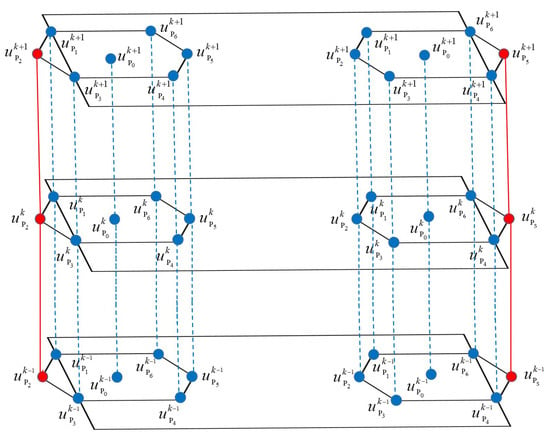
Figure 1.
The illustration of the exact solution at the irregular hexagons with a ghost point at time levels , t and .
Further, we indicate by and . Moreover, let
Next, we give the set of interior hexagonal points and the lateral surface points by
respectively. Let and and . Furthermore, and is the closure of We denote the center of the hexagon by and is the pattern of the hexagon consisting the neighboring points Furthermore, the exact solution at the neighboring points for the time moment is presented by , while is the value on the boundary point as given:
where and the value of if and if . Moreover, present the numerical solution at the same space coordinates of and accordingly for time moments . We also use the following notations in Table 1 to denote the values and partial derivatives of the heat source function f and with respect to the space variables.

Table 1.
Basic notations for the heat source function f and .
For computing numerically the solution of the BVP we use the following difference problem given in Buranay and Arshad [] and call this Stage 1.
- Stage 1
2.2. Dirichlet Problem for the Rate of Change and Difference Problem: Stage 1
Further, for the computation of , we construct the next boundary value problem denoted by which defines the rate of change function
- BVP
Assuming , fourth-order accurate implicit schemes for the solution of the BVP is proposed with the following difference problem. This stage is called Stage 1.
2.3. Matrices and Convergence of Finite Difference Schemes in Stage 1 and Stage 1
Let and , and be real matrices. We denote by () if () for all . Also () if (). Analogous notation is also used for the vectors. Further, let w be a vector with coordinates the vector with coordinates is denoted by For a fixed time level we present the Equations (17) and (28) in matrix form with N unknown interior grid points labeled using standard ordering as
respectively, where and and
and is the neighboring topology matrix, are diagonal matrices with entries
respectively (see Buranay and Arshad []).
Lemma 1.
(Buranay and Arshad []) (a) The matrices and in (31) are symmetric positive definite (spd) matrices
(b) is spd matrix and .
Lemma 2.
The matrix in (31) is nonsingular matrix for
Proof.
Let
From (17) and (36) the error function (36) satisfies the following system as given in Buranay and Arshad: []
where
and and are presented in (17). Analogously, using (28) and (37) the error function (37) satisfies the following system:
where
and , and are the given functions in (27), (29) and (30) respectively.
Further, the following systems are considered:
for where and are given functions. The algebraic systems (44) and (45) at a fixed time level may be given in matrix representation as
accordingly. In these equations, and the matrices and are given in (32).
Proof.
From Lemma 2, when the matrix is nonsingular matrix therefore, Furthermore, from (32) and using (48) it follows that and Further, assuming and from induction we achieve
which gives for Next, assume that using (46)–(50), and by induction it follows that
□
Remark 1.
Writing the implicit schemes on hexagonal grids for the problems (17) and (28) in the canonical form it follows that the maximum principle holds when Further, Lemma 3 is the consequence of comparison theorem (see Chapter 4, Section 4.2 Theorem 1 and Theorem 2 in Samarskii []) applied to the systems (44) and (45).
Additionally, let
Theorem 1.
Proof.
We give the proof of (57) by considering the auxiliary system
and the majorant functions
which satisfy the following difference problem for respectively.
3. Second Stages of the Implicit Methods Approximating and with Order of Convergence
Let
and the corresponding sets of grid points is shown by .
3.1. Hexagonal Grid Approximation to : Stage 2
For obtaining fourth-order accurate numerical approximation to first we apply the implicit method given in Stage 1 and compute the approximate solution . Next, we denote on and use the next problem given in Buranay et al. [].
- Boundary Value Problem for
Taking into consideration we require . Further, we take
where are as in (11), and is obtained by using Stage 1.
Lemma 4.
Proof.
Using (76) and (77) from Theorem 1, and using (57) when gives
where in (59) and d in (61) was defined. In the case it follows that
Therefore, follows (80). □
Lemma 5.
Proof.
On the basis of at the points and of each line segment
we obtain fourth order approximation of by the Formulas (76) and (77). From truncation error formula (see Burden and Faires []) results
Analogously,
Subsequently, for fourth order numerical solution of BVP we propose the following problem and call this Stage 2
- Stage 2
Next, let , where are given in (55) and (56), respectively, and
where and d in (61), also is as given in Lemma 5 and .
Theorem 2.
Proof.
Consider the next system
where
Further, and if and if We take the majorant function
where
The function in (99) satisfies the difference problem
3.2. Boundary Value Problem for and Hexagonal Grid Approximation: Stage 2
First, we construct BVP and obtain the approximate solution by using the implicit method given in Stage 1 Next, we denote on and propose the below problem for
- Boundary Value Problem
From we assume that the solution We take
where and are as given in (27) and is the approximate solution achieved by using Stage 1.
For a fourth-order accurate hexagonal grid approximation of BVP, we propose
- Stage 2
Let where are given in (55) and (56), respectively, and let
where and d is as given in (61). Furthermore, and .
Theorem 3.
Proof.
The proof basically is analogous with the proof of Theorem 2 and follows from the requirement □
4. Second Stages of the Implicit Methods Approximating and with Order of Convergence
4.1. Boundary Value Problem for and Hexagonal Grid Approximation: Stage 2
Let the BVP be given. First, we apply Stage 1 and obtain the approximate solution on the hexagonal grids. Then, by denoting on we use the next problem for proposed in Buranay et al. []
- Boundary Value Problem for
We take
and given in (11) are the initial and boundary functions, respectively, is the solution taken by using Stage 1.
Lemma 6.
Lemma 7.
Proof.
Requiring at the points and of each line segment
we get fourth-order approximation of by the difference Formulas (119) and (120). Then, the truncation error (see Burden and Faires []) yields
□
Second stage of the fourth-order accurate implicit method for the numerical solution to BVP is given as follows:
- Stage 2
Let
Further, let where are given in (55) and (56), respectively, and
where and d is presented in (61) and is as given in Lemma 7 and z is the solution of BVP.
Theorem 4.
Proof.
We take the system
Furthermore, construct the following majorant function:
where
which satisfies the difference problem
4.2. Boundary Value Problem for and Hexagonal Grid Approximation: Stage 2
Let the BVP be given. Then, as the first step we apply the Stage 1 and obtain the approximate solution on the hexagonal grids. Subsequently, denote on and develop the next problem for
- Boundary Value Problem for
We assume We take
where and are as given in (27) and is the approximate solution taken by Stage 1. For a stable fourth-order accurate numerical solution of BVP we propose the next problem:
Stage 2
where and , are defined by (119)–(121) and the operators and are the operators given in (20)–(24) respectively. Additionally,
Let , where are given in (55) and (56), respectively, and
where and d is presented in (61) also and and is the solution of BVP.
Theorem 5.
Proof.
The proof is analogous to the proof of Theorem 4, and follows from the requirement □
5. Experimental Investigations
The proposed fourth order two stage implicit methods are applied on two test problems such that for the first example the exact solution is known. However, for the second example the exact solution is not given. We take , and Further, Mathematica is used for the realization of the algorithms in machine precision. Also we used preconditioned conjugate gradient method with the preconditioning approach given in Buranay and Iyikal [] (see also Concus et al. [] and Axelsson []). We define the following:
- is the given fourth order method for the computation , respectively.
- is the given fourth-order method for the computation , seriatim.
- presents the for one time level spend by the method accordingly.
- shows the for one time level spend by the method , respectively.
Furthermore, , and are the computed grid functions obtained by the methods and , accordingly for and where are positive integers. The error function on the set obtained by , for is presented by while the error function resulting by the methods , are shown with , respectively. Furthermore,
Further, we denote the order of convergence of the approximate solution and to the functions and obtained by using the fourth-order implicit method by
Furthermore, the order of convergence of the approximate solutions and to their corresponding exact solutions and obtained by are given by
We remark that the computed values of (161) and (162) are showing the fourth order convergence of the given methods in and linear convergence in
5.1. Test Problem Example 1
Equations are given as follows:
where
present the heat source and the exact solution respectively and we take . For the Example 1, Table 2 demonstrates and achieved by respectively while Table 3 shows and taken by the method accordingly. Table 2 and Table 3 justify the theoretical results given such that the approximate solutions and converge to the corresponding exact functions and and with fourth order in spatial variables and first order in time for . Moreover, the last two rows in Table 2 and Table 3 demonstrate that the order of convergence is also when .

Table 2.
, for and the convergence orders of and to their exact respective derivatives for the Example 1.

Table 3.
, , for and the convergence orders of and to their exact respective derivatives for the Example 1.
Figure 2 and Figure 3 illustrate the grid functions and , respectively, when obtained by the corresponding method for the Example 1. Figure 4 and Figure 5 demonstrate the grid functions , and for respectively, for achieved by applying the corresponding method for the Example 1.

Figure 2.
The grid function of absolute errors when obtained by the method for the Example 1.
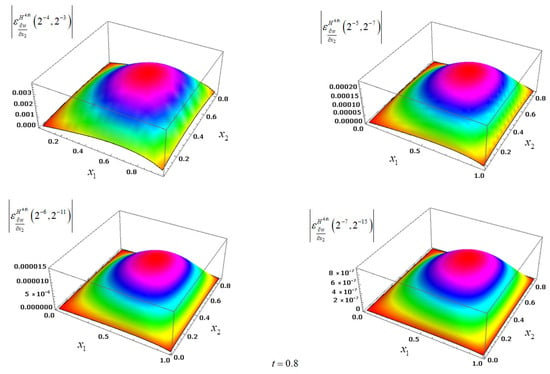
Figure 3.
The grid function of absolute errors when obtained by the method for the Example 1.

Figure 4.
The grid function of absolute errors when obtained by the method for the Example 1.
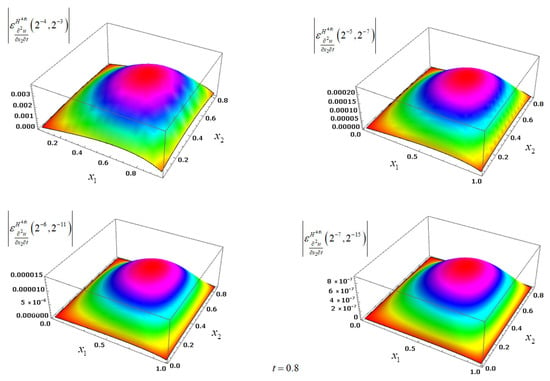
Figure 5.
The grid function of absolute errors when obtained by the method for the Example 1.
5.2. Test Problem Example 2
Equations are given as follows:
The heat source function is
The problem in Example 2 is a benchmark problem such that the solution is not provided. An analogous problem with zero heat source was also considered in Henner et al. []. By applying the proposed methods we obtain the approximate solutions and accordingly at every time level for the considered values ,7 and . Table 4 and Table 5 present and , respectively, at the grid points and and the corresponding order of convergence for at the grid point given as

Table 4.
The numerical solution at seven points when , and the convergence orders obtained by for the Example 2.

Table 5.
The numerical solution at seven points when , and the convergence orders obtained by for the Example 2.
By the same way Table 6 and Table 7 show and , respectively, at the the considered grids and the corresponding convergence orders for at the point defined as

Table 6.
The numerical solution at seven points when , and the convergence orders obtained by for the Example 2.

Table 7.
The numerical solution at seven points when , and the convergence orders obtained by for the Example 2.
The computed solutions and achieved by using the corresponding two stage method are demonstrated in Figure 6 and Figure 7 for the time levels and . Figure 8 and Figure 9 illustrate the approximate solutions and taken by using the respective two stage method for time levels and .
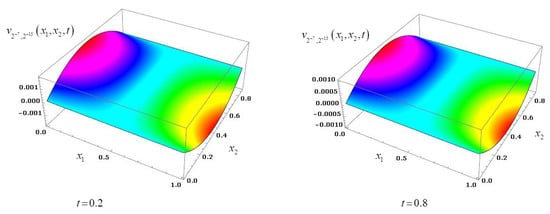
Figure 6.
The approximate solution at time levels and obtained by the method for the Example 2.
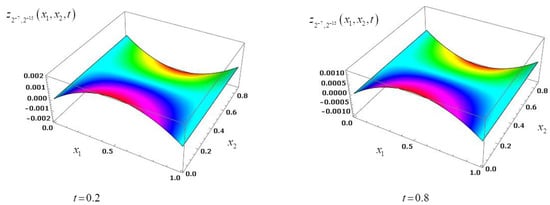
Figure 7.
The approximate solution at time levels and obtained by the method for the Example 2.

Figure 8.
The approximate solution at time levels and obtained by the method for the Example 2.
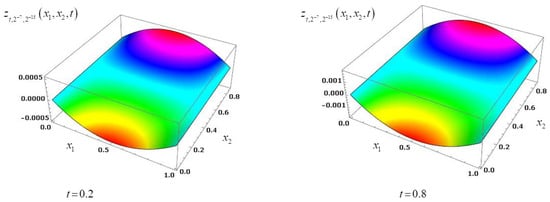
Figure 9.
The approximate solution at time levels and obtained by the method for the Example 2.
6. Conclusions
Numerical methods using implicit schemes defined on hexagonal grids are proposed for computing the derivatives of the solution to Dirichlet problem of heat equation on rectangle. For the required smoothness conditions of the solution and when the uniform convergence of the constructed difference schemes on the grids to the respective exact derivatives and is shown to be .
Novelty Statement:
In Buranay et al. [], we gave a second-order hexagonal grid approximation of the first-order spatial derivatives of the solution to BVP in (11) with the smoothness condition in the Hölder space. The method was established in two stages. In this study, we require that , and give hexagonal grid computation of all the first order derivatives and the mixed order second order derivatives involving the time derivative by developing two stage implicit methods of fourth order accurate in space variables.
Author Contributions
Conceptualization, S.C.B.; Methodology, S.C.B.; Software, N.A. and A.H.M.; Validation, S.C.B., N.A. and A.H.M.; Formal Analysis, S.C.B., N.A. and A.H.M.; Investigation, N.A. and A.H.M.; Resources, S.C.B., N.A. and A.H.M.; Writing—Review and Editing, S.C.B., N.A. and A.H.M.; Visualization, S.C.B., N.A. and A.H.M.; Supervision, S.C.B.; Project Administration, S.C.B. All authors have read and agreed to the published version of the manuscript.
Funding
This research did not receive any specific grant from funding agencies in the public, commercial, or not-for-profit sectors.
Informed Consent Statement
Not applicable.
Data Availability Statement
No data is used.
Conflicts of Interest
The authors declare no conflict of interest.
References
- Fokker, A.D. Die mittlere Energie rotierender elektrischer Dipole im Strahlungsfeld. Ann. Phys. 1914, 348, 810–820. [Google Scholar] [CrossRef]
- Planck, M. Über einen Satz der statistischen Dynamik und seine Erweiterung in der Quantentheorie. Sitzungsberichte der Preussischen Akademie der Wissenschaften zu Berlin 1917, 24, 324–341. [Google Scholar]
- Kolmogorov, A. Über die analytisehen Methoden in der Wahrseheinliehkeitsreehnung. Math. Ann. 1931, 104, 415–458. (In German) [Google Scholar] [CrossRef]
- Mandelbrot, B.; Hudson, R. The (Mis)behavior of Markets: A Fractal View of Risk, Ruin, and Reward; Basic Books: New York, NY, USA, 2004; ISBN 978-0-465-04355-0. [Google Scholar]
- Meline, A.; Triboulet, J.; Jouvencel, B. A camcorder for 3D underwater reconstruction of archeological objects. In Proceedings of the OCEANS 2010 MTS/IEEE SEATTLE, Seattle, WA, USA, 20–23 September 2010; pp. 1–9. [Google Scholar]
- Wozniak, M.; Połap, D. Soft trees with neural components as image-processing technique for archeological excavations. Pers. Ubiquitous Comput. 2020, 24, 363–375. [Google Scholar] [CrossRef]
- Ziegler, A.; Kunth, M.; Mueller, S.; Bock, C.; Pohmann, R.; Schröder, L.; Faber, C.; Giribet, G. Application of magnetic resonance imaging in zoology. Zoomorphology 2011, 130, 227–254. [Google Scholar] [CrossRef]
- Zeng, G.L. Medical Image Reconstruction: A Conceptual Tutorial; Springer: Berlin/Heidelberg, Germany; Higher Education Press: Beijing, China, 2010. [Google Scholar]
- Witkin, A.P. Scale-Space Filtering. In Proceedings of the 8th International Joint Conference on Artificial Intelligence, Karlsruhe, Germany, 8–12 August 1983; Volume 2. pp. 1019–1022. [Google Scholar]
- Koenderink, J.J. The structure of images. Biol. Cybern. 1984, 50, 363–370. [Google Scholar] [CrossRef]
- Rudin, L.I.; Osher, S.; Fatemi, E. Nonlinear total variation based noise removal algorithms. Physica D 1992, 60, 259–268. [Google Scholar] [CrossRef]
- Guichard, F.; Morel, M. A note on two classical enhancement filters and their associated pde’s. Int. J. Comput. Vis. 2003, 52, 153–160. [Google Scholar] [CrossRef]
- Wolpert, L. Positional information and the spatial pattern of cellular differentiation. J. Theor. Biol. 1969, 25, 1–47. [Google Scholar] [CrossRef]
- Wolpert, L. The development of pattern and form in animals. Carol. Biol. Readers 1977, 1, 1–16. [Google Scholar]
- Murray, J.D. Mathematical Biology II: Spatial Models and Biomedical Appications, 3rd ed.; Springer: Berlin/Heidelberg, Germany, 2003. [Google Scholar]
- Grossmann, C.; Roos, H.G.; Stynes, M. Numerical Treatment of Partial Differential Equations; Springer: Berlin/Heidelberg, Germany, 2007. [Google Scholar]
- Abirami, A.; Prakash, P.; Thangavel, K. Fractional diffusion equation-based image denoising model using CN–GL scheme. Int. J. Comput. Math. 2018, 95, 1222–1239. [Google Scholar] [CrossRef]
- Buranay, S.C.; Arshad, N. Hexagonal grid approximation of the solution of heat equation on special polygons. Adv. Differ. Equ. 2020, 2020, 309. [Google Scholar] [CrossRef]
- Volkov, E.A. On convergence in C2 of a difference solution of the Laplace equation on a rectangle. Russ. J. Numer. Anal. Math. Model 1999, 14, 291–298. [Google Scholar] [CrossRef]
- Dosiyev, A.A.; Sadeghi, H.M. A fourth order accurate approximation of the first and pure second derivatives of the Laplace equation on a rectangle. Adv. Differ. Equ. 2015, 2015, 1–11. [Google Scholar] [CrossRef]
- Volkov, E.A. On the grid method by approxımating the derivatives of the solution of the Drichlet problem for the Laplace equation on the rectangular parallelpiped. Russ. J. Numer. Anal. Math. Model. 2004, 19, 209–278. [Google Scholar] [CrossRef]
- Dosiyev, A.A.; Sadeghi, M.H. On a highly accurate approximation of the first and pure second derivatives of the Laplace equation in a rectangular parellelpiped. Adv. Differ. Equ. 2016, 2016, 1–13. [Google Scholar] [CrossRef][Green Version]
- Dosiyev, A.A.; Abdussalam, A. On the high order convergence of the difference solution of Laplace’s equation in a rectangular parallelepiped. Filomat 2018, 32, 893–901. [Google Scholar] [CrossRef]
- Dosiyev, A.A.; Sarikaya, H. 14-Point difference operator for the approximation of the first derivatives of a solution of Laplace’s equation in a rectangular parallelepiped. Filomat 2018, 32, 791–800. [Google Scholar] [CrossRef]
- Buranay, S.C.; Farinola, L.A. Implicit methods for the first derivative of the solution to heat equation. Adv. Differ. Equ. 2018, 2018, 1–21. [Google Scholar] [CrossRef]
- Buranay, S.C.; Matan, A.H.; Arshad, N. Two stage implicit method on hexagonal grids for approximating the first derivatives of the solution to the heat equation. Fractal Fract. 2021, 5, 19. [Google Scholar] [CrossRef]
- Barrera, D.; Guessab, A.; Ibáñez, M.J.; Nouisser, O. Increasing the approximation order of spline quasi-interpolants. J. Comput. Appl. Math. 2013, 252, 27–39. [Google Scholar] [CrossRef]
- Guessab, A. Approximations of differentiable convex functions on arbitrary convex polytopes. Appl. Math. Comput. 2014, 240, 326–338. [Google Scholar] [CrossRef]
- Buranay, S.C.; Iyikal, O.C. Incomplete block-matrix factorization of M-matrices using two step iterative method for matrix inversion and preconditioning. Math. Methods Appl. Sci. 2021, 44, 7634–7650. [Google Scholar] [CrossRef]
- Concus, P.; Golub, G.H.; Meurant, G. Block preconditioning for the conjugate gradient method. SIAM J. 1985, 6, 220–252. [Google Scholar] [CrossRef]
- Axelsson, O. A general incomplete block matrix factorization method. Linear Algebra Its Appl. 1986, 74, 179–190. [Google Scholar] [CrossRef][Green Version]
- Volkov, E.A. Differentiability properties of solutions of boundary value problems for the Laplace and Poisson equations on a rectangle. Trudy Mat. Inst. Steklov. 1965, 77, 89–112. [Google Scholar]
- Ladyženskaja, O.A.; Solonnikov, V.A.; Ural’ceva, N.N. Linear and Quasi-linear Equations of Parabolic Type. In Translation of Mathematical Monographs; American Mathematical Society: Providence, RI, USA, 1967; Volume 23. [Google Scholar]
- Friedman, A. Partial Differential Equations of Parabolic Type; Robert E. Krieger Publishing Company: Malabar, FL, USA, 1983. [Google Scholar]
- Azzam, A.; Kreyszig, E. On solutions of parabolic equations in regions with edges. Bull. Aust. Math. Soc. 1980, 22, 219–230. [Google Scholar] [CrossRef][Green Version]
- Azzam, A.; Kreyszig, E. Smoothness of solutions of parabolic equations in regions with edges. Nagoya Math. J. 1981, 84, 159–168. [Google Scholar] [CrossRef][Green Version]
- Samarskii, A.A. Theory of Difference Schemes; Marcel Dekker Inc.: New York, NY, USA, 2001. [Google Scholar]
- Burden, R.L.; Faires, J.D. Numerical Analysis Brooks/Cole; Cengage Learning: Boston, MA, USA, 2011. [Google Scholar]
- Henner, V.; Belozerova, T.; Forinash, K. Mathematical Methods in Physics, Partial Differential Equations; Fourier Series, and Special Functions; AK Peters Ltd.: Wellesley, MA, USA, 2009. [Google Scholar]
Publisher’s Note: MDPI stays neutral with regard to jurisdictional claims in published maps and institutional affiliations. |
© 2021 by the authors. Licensee MDPI, Basel, Switzerland. This article is an open access article distributed under the terms and conditions of the Creative Commons Attribution (CC BY) license (https://creativecommons.org/licenses/by/4.0/).